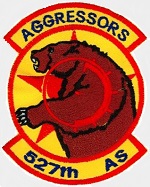Hobby Master HA3821 USAF General Dynamics F-16C Viper Fighter - 527th Aggressor Squadron, CO, "Bentwaters Aggressors", June 1989 (1:72 Scale)
"Obsolete weapons do not deter."
- British Prime Minister Margaret Thatcher
 Even at the ripe old age of 20, the F-16 Falcon remains a fast and potent favorite among fighter pilots, and one of the best fighters in its class. Designed originally as a no-frills, single-engine "hot rod", the addition of improved radar and weaponry have made the Falcon a super, lightweight jet. Used mainly as a bomber, the Fighting Falcon can also turn-and-burn with unbridled fury when provoked. It is also one of the first operational fly-by-wire aircraft; its flight controls being electronically operated and computer controlled. A 20mm cannon, Maverick missiles, and laser-guided bombs make the F-16 a potent multi-role fighter. However, it's light weight, speed and agility make it the choice of the US Air Force's Thunderbirds aerobatic team.
Even at the ripe old age of 20, the F-16 Falcon remains a fast and potent favorite among fighter pilots, and one of the best fighters in its class. Designed originally as a no-frills, single-engine "hot rod", the addition of improved radar and weaponry have made the Falcon a super, lightweight jet. Used mainly as a bomber, the Fighting Falcon can also turn-and-burn with unbridled fury when provoked. It is also one of the first operational fly-by-wire aircraft; its flight controls being electronically operated and computer controlled. A 20mm cannon, Maverick missiles, and laser-guided bombs make the F-16 a potent multi-role fighter. However, it's light weight, speed and agility make it the choice of the US Air Force's Thunderbirds aerobatic team.
The F-16C (single seat) and F-16D (two seat) variants entered production in 1984. The first C/D version was the Block 25 with improved cockpit avionics and radar which added all-weather capability with beyond-visual-range (BVR) AIM-7 and AIM-120 air-air missiles. Block 30/32, 40/42, and 50/52 were later C/D versions. The F-16C/D had a unit cost of US$18.8 million (1998). Operational cost per flight hour has been estimated at $7,000 to $22,470 or $24,000, depending on calculation method.
Pictured here is a gorgeous 1:72 scale diecast replica of a USAF General Dynamics F-16C Viper fighter that was attached to the 527th AS "Bentwaters Aggressors", during June 1989.
Sold Out!
Dimensions:
Wingspan: 7-inches
Length: 8-inches
Release Date: March 2015
 Historical Account: "Aggressive Tendencies" - In April 1976, the squadron was reactivated at RAF Alconbury, England, as the 527th Tactical Fighter Training and Aggressor Squadron, becoming the United States Air Forces in Europe's only aggressor squadron. The 527th began providing aggressor support to European-based combat units in September. Its mission was to train United States Air Forces Europe fighter pilots for air combat with Eastern bloc adversaries using "Dissimilar Air Combat Training" (DACT)
Historical Account: "Aggressive Tendencies" - In April 1976, the squadron was reactivated at RAF Alconbury, England, as the 527th Tactical Fighter Training and Aggressor Squadron, becoming the United States Air Forces in Europe's only aggressor squadron. The 527th began providing aggressor support to European-based combat units in September. Its mission was to train United States Air Forces Europe fighter pilots for air combat with Eastern bloc adversaries using "Dissimilar Air Combat Training" (DACT)
The squadron was equipped with the Northrop F-5E Tiger II, being originally part of an order of aircraft destined for South Vietnam. The first batch of eight aircraft were air-freighted into Alconbury on May 21st, 1976, on board a Lockheed C-5A Galaxy direct from the production facility at Palmdale, California. Eight more Tigers arrived on 14 June with the final batch of four following ten days later, on 24 June. These aircraft were also airfreighted on board a C-5A. The 527th was fully operational a few months later with the first DACT course commencing in October 1976
The aggressor F-5Es were painted in a variety of colorful camouflage schemes designed to mimic those in use by Warsaw Pact aircraft. Two-digit Soviet-style nose codes were applied to most aggressor aircraft. These coincided with the last two digits of the serial number. When there was duplication, three digits were used.
International conventions made it necessary for military aircraft to carry their national insignia, but the star-and-bar national insignia was reduced in size and relocated to a less-conspicuous position on the rear fuselage. The 527th's Aggressor aircraft were among the first to apply the star and bar in toned-down or stencil form, now standard on USAF aircraft.
The 527th Aggressors flew their aircraft in intense turns and other maneuvers as their mission involved intense combat fighter training, often involving high-G turns at supersonic speeds. The Aggressors trained both United States Air Force squadrons in Soviet fighter tactics, but deployed frequently to other NATO airfields, training pilots from Norway to Greece and Turkey, France, West Germany and the Low Countries in combat tactics.
After 12 years of intense flying, in 1988 the fleet of aggressor F-5Es were getting rather worn out as a result of sustained exposure to the rigors of air combat maneuvering. There were restrictions placed on operations in which pilots were warned not to exceed a certain G-load. Some repair kits had to be devised to overcome these problems, and the estimated cost of repair of the entire fleet was beginning to exceed a billion dollars. In addition, with the appearance of a new generation of Soviet fighters, it became apparent that F-5Es could no longer adequately mimic Warsaw Pact threats.
It was decided to re-equip the squadron with General Dynamics F-16C Fighting Falcons and move the squadron to RAF Bentwaters. In return, the Fairchild Republic A-10 Thunderbolt II's at Bentwaters would move to Alconbury and give the 10th Tactical Fighter Wing a new close air support mission.









